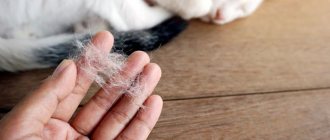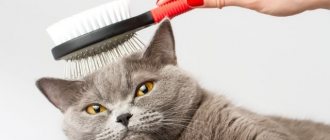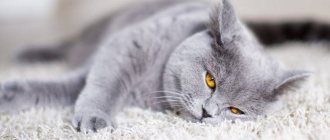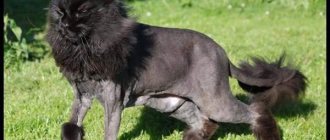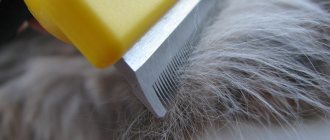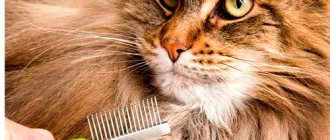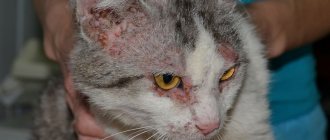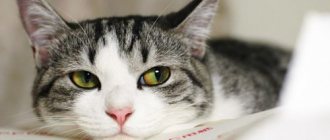It's no secret that pets bring many pleasant moments to their owners. They, in turn, are obliged to carefully monitor the health and good mood of their pets. Proper nutrition and daily care will allow your cat to look just perfect.
Responsible pet owners regularly visit a veterinarian and monitor the health of their pets. Coat care requires special attention. It happens that a cat's hair comes out a lot. What to do? How to help your pet and prevent this from happening in the future?
Causes
First, you should determine why your cat is losing hair and think about whether the negative impact can be eliminated. However, there is no need to panic. If a cat loses a clump of hair, this does not mean that it is dying. The reasons may be different:
Seasonal shedding. Have you noticed that your cat has a lot of hair coming out? What to do? First, take a close look at the calendar. Is your cat not looking sick and hairless, but is actively shedding excess hair? It is likely that she is simply molting. This usually happens twice a year: in autumn and spring. For “apartment” cats that do not go outside, the process may take 2–3 months. There's no need to panic. Instead of the old fur, a new beautiful fur coat will quickly grow.
Dermatitis. It can be allergic and contact. When a cat's fur comes out in clumps and obvious bald patches appear, owners have cause for concern. In the future, bald spots may become covered with scales, turn red and itch. You should immediately see a doctor and determine the cause of the disease. It is likely that this is how the animal reacts to certain foods or new food.
Flea dermatitis. If the resulting bald patches are itchy and covered with crusts and scales, there is reason to suspect a severe reaction to fleas. During this period, the cat’s temperature may rise, and it is very easy to see uninvited “guests” between the hairs.
Skin mite. The disease can be identified by bald paws and muzzle. The hair on the ears also noticeably thins, and throughout the body it becomes dull and unkempt. Self-medication is not enough; you will have to visit a veterinarian.
Lichen. In this case, the hair does not just climb, but falls out in whole pieces. Unsightly bald spots form that quickly increase in size. At the slightest suspicion, you need to show the animal to a doctor as soon as possible.
Stress. A cat can shed heavily in response to new impressions or an unusual environment. The catalyst can be the appearance of other animals in the family, a move, the birth of a baby, the death of the owner, and more.
Avitaminosis. Lack of nutrients, change of feed, seasonal manifestations, lack of certain organic compounds.
Age-related changes. The cat seems to be healthy, but the hair on the ears and face has noticeably thinned out? Your cat is already many years old. In this case, hair loss is associated with poor nutrition of the hair follicles.
Hormonal disbalance. The appearance and thickness of the coat can be affected by pregnancy, estrus, birth and feeding of kittens, and birth control drops and pills that the cat takes.
Fleas
Owning a dog and a cat, or living in an area where the cat has easy access to the outdoors, may be the reason your feline suddenly loses its fur in clumps. If a cat is able to go outside and socialize in nature or is in close contact with a dog every day, he may be bitten by a flea.
Now the cat can avoid losing hair because of the fleas themselves. The cause of baldness in this case is an allergy to flea bites. If a feline is sensitive to flea saliva, it may develop alopecia, especially in the hindquarters.
Unfortunately, it only takes one flea to cause a rather unpleasant and sometimes long-lasting reaction. This is why it is important to take your cat to the vet immediately to avoid further damage to the skin and fur.
Luckily, this condition is easy to treat with some flea treatments and shampoo. If the itching persists and hair loss is excessive, your veterinarian may also prescribe antihistamines or corticosteroids.
How to diagnose hair loss?
How can you tell if your cat has a lot of hair? What to do and how to help the animal?
It is simply impossible not to notice the problem. Cats with long hair lose fur so actively that literally everything becomes covered with hair. Short-haired breeds shed their hair less noticeably, but it is still noticeable. If the pussy is outwardly alert and cheerful, actively eating and playing, but the number of lost hairs has increased, there is no need to worry. We are most likely talking about a trivial molt.
You should take your pet to the vet immediately if:
- The pet's behavior has changed. He is too active or apathetic, shows aggression, sleeps more than usual, scratches himself or chews out pieces of fur.
- The hair falls out unevenly, and bald patches and bald spots appear.
- Hair loss is accompanied by the appearance of wounds, pustules or scales.
- The cat has dandruff, fungal manifestations or other troubles.
The doctor will make an accurate diagnosis and prescribe appropriate treatment. You may need to get tested.
Fungal infection (ringworm)
Although there is a “worm” in this disease, it is actually a fungal infection that can be easily transmitted to people. Cats usually become ill from contact with other infected animals. From there, the infection spreads and can wreak havoc on your home, whether you have a cat or a kitten.
Hair loss in clumps is the most common symptom. A ringworm infection causes the hair to become quite brittle so it breaks, leaving behind clumps. The areas most commonly affected are around the feet, ears and face.
The skin will also show signs of infection; The ears, feet and parts of the face may appear slightly reddish, and there may also be white or gray crusts. In general, hairless skin will appear dry and flaky.
Looking for an answer to the question, why does my cat's fur fall out in clumps? this infection seemed like the biggest red flag to me. Since my cat was leaving clumps of fur behind her and some of the hairless parts were quite dry to the touch, I had to confirm the diagnosis with a vet.
Fortunately, the cat recovered quickly. To confirm the infection, the veterinarian tested a fungal skin culture. Treatment included the use of various antifungal agents such as shampoos, sprays and creams. Treatment may also include oral medications, but they were not necessary in our case.
How to help your pet?
Once your doctor determines why your cat is losing hair, treatment should begin immediately. In some cases, you can do without medications. Sometimes it is enough:
- adjust the animal’s diet, add previously missing products to it, remove excess;
- Regularly brush your pet with a special brush and bathe it;
- do not ignore preventive vaccinations;
- walk your pet more often;
- calm the cat, show care and attention when it comes to stressful manifestations;
- choose a special vitamin complex to improve the condition of the coat.
How to treat hair loss?
If hair loss is associated with allergies, the following measures will help:
- identify the allergen, exclude salty and fatty foods from the diet;
- adhere to a special balanced diet recommended by your doctor;
- if you were given dry cat food, it is better to use a medicinal product for wool, recommended for animals prone to dermatitis;
- add special vitamins for wool to food;
- Give antiallergic drugs prescribed by your doctor.
If the dermatitis is of a flea nature, then first you need to get rid of the “neighbors”. Special preparations will help: shampoos, drops, collars or spray.
Self-treating shingles can be problematic. It is important to contact a competent specialist as quickly as possible. You will also have to:
- clean all carpets, bedspreads and furniture in the house with a disinfectant;
- wash and iron all clothes;
- disinfect the premises;
- Throw away, or better yet, burn all bedding, rugs and the animal’s house.
Hormonal imbalance
Now, when looking for an answer to the question of why is my cat losing hair in clumps, don't be surprised if you see hyperthyroidism on the list of common causes. When a cat suffers from overproduction of T4, its coat will often appear unkempt and greasy, with small bald patches here and there.
This is just one symptom of an overactive thyroid. To diagnose the disease, a veterinarian must not only check hormone levels, but also rule out kidney failure and diabetes. Both of these conditions have common symptoms.
On the other hand, a cat may be suffering from a hormonal imbalance unrelated to its thyroid gland. Its steroid levels can be high, causing hair follicles to die, often symmetrically. One of the most common causes of this is Cushing's disease, a metabolic disorder that can be quite difficult to diagnose. It shares many of the same symptoms as diabetes, but can also lead to hair loss and thin, fragile skin.
In both cases, medications and surgery are possible. If it is hyperthyroidism, the cat may also be given radioactive iodine therapy.
In some rare cases, cats that develop cancer may also suffer from alopecia. It is mainly caused by neoplasia, the presence of abnormal growths that occur due to uncontrolled cell division. Additionally, cats may develop paraneoplastic alopecia (the skin will be moist but itchy) due to pancreatic malignancy, metastatic intestinal carcinoma, or bile duct carcinoma.
How to choose the right vitamins?
So, you noticed that your cat's hair is shedding a lot. What to do? If you are sure that the pussy is healthy and there is no reason to visit the veterinarian, you can simply buy a special vitamin complex. The choice will depend on several factors:
- age of the cat (vitamins are different for kittens and old cats);
- presence of pregnancy;
- preservation of the ability to reproduce (castrated and sterilized animals need a special complex);
- release form of the drug (gel, tablets, drops, paste);
- availability of a product certificate.
Popular cat vitamins for a healthy coat
There are a lot of preparations to improve the condition of the coat. It is best if they are selected and prescribed by a doctor. The most popular vitamins for cats against hair loss are:
- "Farmavit Neo";
- Cat Felltop Gel;
- "Vittri";
- Laveta Super For Cats;
- "Phytomins";
- Derm Liquid;
- "Sherstevit";
- Derm Caps;
- "Beafar";
- Gimpet Katzentabs;
- "Kitzim";
- Kitty's + Taurin + Biotin;
- Canina Cat-Fell OK;
- “8 in 1 Brewer’s Yeast Excel”;
- "Felvit."
Furminator for hair care
To help your cat renew its coat faster and get rid of tangles, it is best to use a special device. The Furminator is perfect for long-haired cats. Initially, the word was the name of the trademark of one American company, which developed the device. Now this is the name given to all manual “combers” that combine the functions of a slicker, comb and trimmer.
A cat's fur is not like human hair. Several hairs grow from one follicle at once: central; 2–3 additional, undercoat and down. In order for the animal to look beautiful and neat, the old fur must be removed. Otherwise, your cat will shed all year round.
Regular combs are not able to process the undercoat; special combs damage the top layer of skin. The Furminator for long-haired cats does not have all these disadvantages. Outwardly, it is similar to a razor, but instead of a traditional blade, it has a special metal comb with sharpened teeth. With its help it is very easy to process the undercoat and remove dead hairs. Living hairs remain intact.
Removing mats at home
Before cutting off a cat’s mats, you need to assess the situation and make sure that you don’t need the help of a specialist. If your pet looks like one solid matted lump, you will have to take the animal to the veterinarian or groomer.
How to remove mats from a cat:
- Small lumps are sorted out by hand or plucked out;
- Large tangles are cut with scissors with rounded tips (or a tangle cutter is used) along the hair growth, and individual parts of the lump are separated by hand;
- If there is a lot of matted wool, the clumps are very dense, then they also need to be first cut lengthwise and then cut off in sections, as far away from the animal’s skin as possible.
After getting rid of the tangles, the pet must be combed out. And then wash and comb thoroughly again, first with a wide-tooth comb, then with a slicker brush and finally with a furminator.
How to choose the right device?
To choose the right furminator, it is important to pay attention to the following points:
- Scallop width. The larger the animal, the wider the comb should be.
- Length of teeth. It should match the length of the animal's fur. Teeth that are too short will not reach the undercoat of “fluffy cats,” and teeth that are too long will not be suitable for short-haired cats.
- Quality of tooth sharpening. They should be even, smooth, without nicks or irregularities. Defects in sharpening interfere with quality combing. Irregularities will tug the fur and injure the skin. To check the quality of sharpening, run the furminator over your own head. If you do not experience any unpleasant sensations, the quality of sharpening is normal. Pulling hair? The sharpening was unsuccessful.
- Ejector button. Its presence allows you to get rid of hairs on the work surface in one motion. It must be remembered that such devices fail faster.
- Comfortable handle. It is best if the handle is rubberized, has a convex relief and a rounded end. Hold the Furminator in your hand, feel its weight, and measure the length of the handle against your palm.
Not long ago, universal furminators went on sale. They have removable combs of varying lengths and widths. With their help you can care for several pets of different sizes. But the moving connection becomes loose over time and the device becomes unusable.
What are the dangers of matted wool?
At first glance, harmless felt lumps pose a danger to your pet’s body. Over time, they become more numerous, and in the end you will have to shave the cat almost bald, which is dangerous due to impaired thermoregulation and sunburn. A completely shaved coat will take 5 to 8 months to grow back, depending on the length. In young animals (under 1 year of age), it may not recover completely.
Why are mats dangerous in cats?
- Violation of thermoregulation of the epidermis. The skin under the hairball swells, causing discomfort to the pet.
- Itching. The cat cannot scratch the skin under the mat normally, which leads to chronic itching (especially in the presence of ectoparasites), the pet becomes nervous and restless;
- Accumulation of bacteria. The cat cannot fully lick and disinfect the skin, and the pathogenic flora, together with diaper rash under the mat, provokes inflammatory processes on the skin and the development of dermatitis;
- Skin injuries. Constant itching provokes the animal to constantly itch, but due to the inability to do this normally, cats often overdo it and injure the skin with their claws.
Among other things, the violation of the aesthetic appearance cannot be overlooked. A cat with mats looks unkempt and is unlikely to receive a good mark at the show.
Grooming rules
A good cat hair brush is not the only thing a responsible owner will need. It is very important to bathe cats of any breed. Moreover, this must be done at least 3 times a year. Of course, the cat itself regularly cleans its fur using its tongue. But it will not be able to cope with microscopic particles of sebum and dust. Over time, they clog pores and the skin receives less oxygen. The animal's fur becomes dull, brittle and falls out more.
For bathing, you should use special products for cats: shampoos and conditioners. It is unacceptable to use “human” ones. Owners of long-haired animals have even more worries. Several times a year they need to give their pets a “dry” bath. To do this, you need to sprinkle a special powder on the animal’s fur, and after some time comb it out thoroughly.
It is very important to brush your cat properly and regularly. Long-haired dogs should undergo this procedure daily, and short-haired dogs should undergo this procedure at least 2 times a week. Combing does more than just get rid of dead hairs. It is also a kind of massage that stimulates blood circulation.
When a large lump of matted fur is discovered during combing, it is worth trying to disassemble it. If it doesn’t work out, you must definitely get rid of the tangle, for example, cut it out. If this is not done, it will increase in size and can become a source of infection or a nest for fleas.
How to comb a cat
It is necessary to choose the right combs and brushes based on the type of coat. Some brushes have a massage effect and stimulate blood flow to the skin. During the procedure, you need to be careful not to injure your pet. For this reason, it is advisable to select brushes with protected ends.
There are several basic tools for combing pets:
- Furminator - a comb with rectangular teeth. Suitable for removing mats from long-haired pets. You can also do massage with it;
- mitten - covered with pimples or teeth. Convenient to use;
- slicker brush - a comb with teeth;
- comb.
The selection of brushes and combs depends on the cat’s coat. Ideally, you should consult your veterinarian about purchasing a suitable tool.
Long wool
It is recommended to brush long-haired pets every day, otherwise the hair will become tangled. Caring for long hair requires:
- a metal brush with natural bristles;
- comb with frequent and rare teeth;
- smoothing brush.
Using a soft brush, you need to comb your pet against the fur, in the direction of its growth - we must not forget about the belly and tail. After this, the matted fur is combed out with a comb and the fur on the muzzle and collar is combed (you can use a toothbrush).
It is important to remember that you can only comb dry hair, as wet hair gets tangled more easily.
Short hair
Some owners, when purchasing a short-haired cat, hope that they will not have to brush it, because it “can do it itself.” In fact, the fur of such cats also needs care. To do this you will need the following tools:
- comb for cats with fine teeth;
- brush with soft bristles;
- suede (for polishing wool);
- rubber brush.
You need to go through the comb several times from the scruff to the tail - and back. Then you can massage the cat with a rubber brush, smooth the fur and polish it a little with a piece of suede. It is recommended to regularly run a wet hand over the animal’s fur to remove dead hairs - this trick is often used by British owners. Scottish cats need to be combed with a sparse comb from tail to head and vice versa. A brush with natural bristles adds shine to the fur.
Preventing Excessive Shedding
To keep your pet healthy and its fur not decorating your trousers, carefully monitor its diet:
- do not give your animal harmful foods: spicy, smoked, salty or fried foods;
- if you use ready-made food, purchase only a high-quality product from a well-known brand;
- include a sufficient amount of vitamins and microelements in your diet;
- do not overfeed your pet, especially if it is not young;
- Take your cat to the veterinarian regularly and do not neglect the required vaccinations.
Even if your cat has never been outside, this does not mean that she cannot get sick. We bring a variety of infections home ourselves, on clothes and shoes.
How to brush a cat well
A small kitten won’t produce a lot of hair on the carpet, but the time of seasonal molting comes, and hairs appear here and there: on furniture, soft rugs, and clothes. Many owners of Persians or “Siberians” turn to the services of groomers, cutting their cat short for the summer. This does not help for long - the fur grows back, and in the fall the problem arises again. You need to brush your cat not occasionally, but daily. This is a good massage that has a beneficial effect not only on the condition of the coat, but also improves blood circulation. But the procedure must be carried out correctly.
